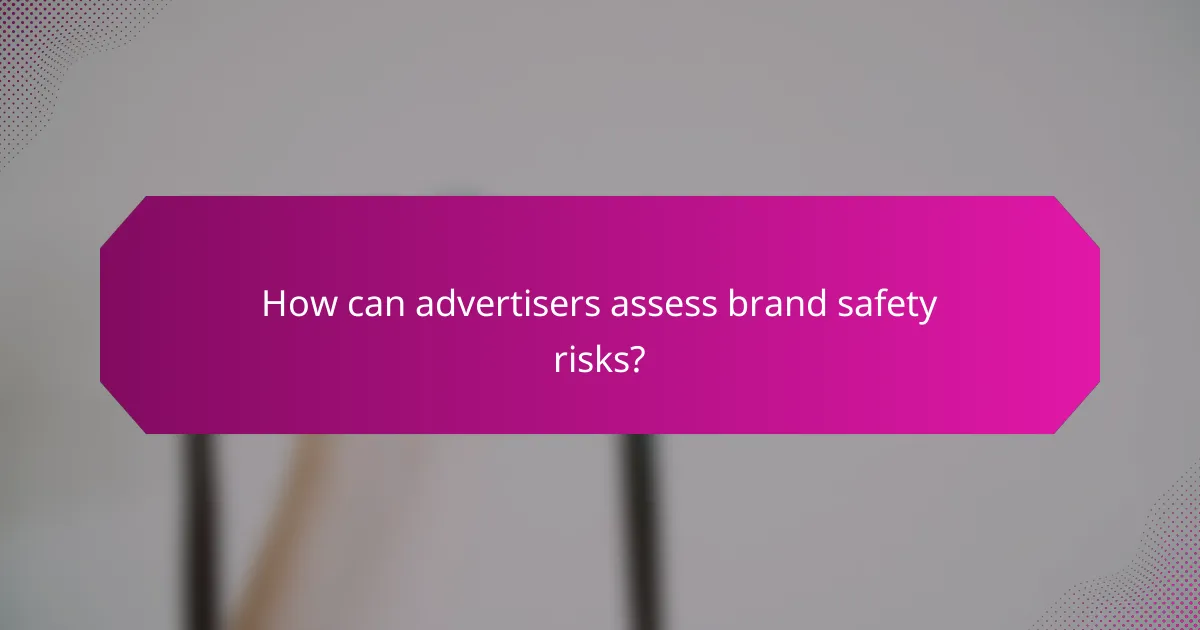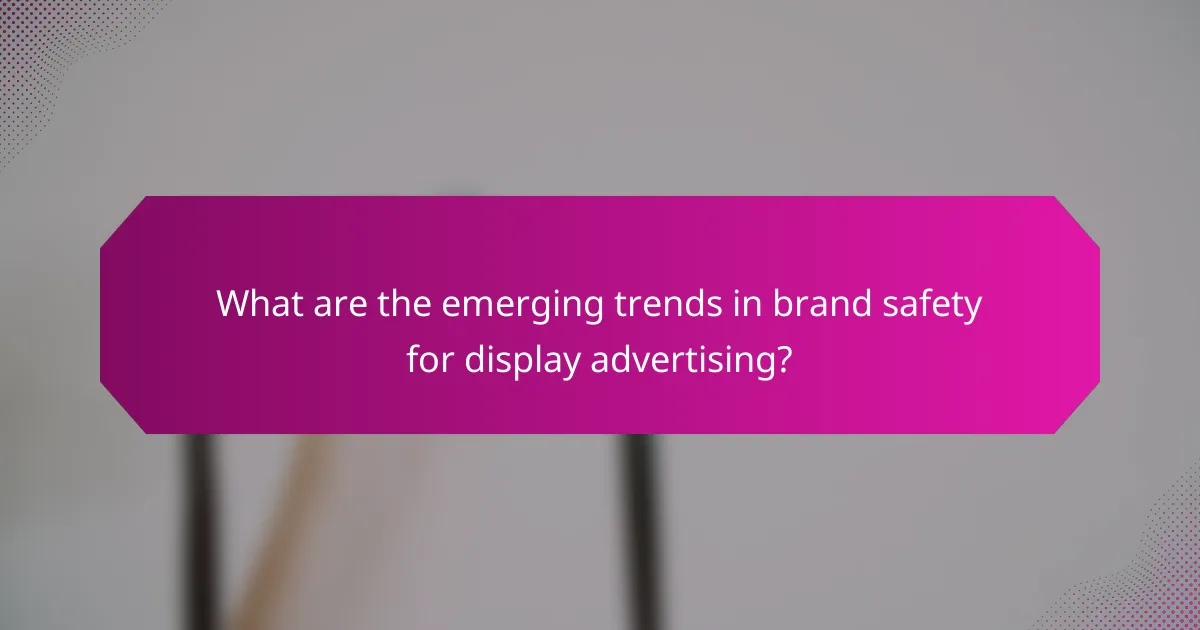Brand safety in display advertising is essential for protecting a company’s reputation and maintaining consumer trust. By employing strategies such as utilizing specialized tools, implementing whitelists and blacklists, and conducting regular audits, advertisers can effectively mitigate risks associated with inappropriate content. Additionally, adhering to industry standards provides a framework that helps ensure ads are placed in safe environments, further safeguarding brand integrity.

What are the key strategies for brand safety in display advertising?
Key strategies for ensuring brand safety in display advertising include utilizing specialized tools, implementing whitelists and blacklists, conducting regular audits, and engaging with trusted partners. These approaches help mitigate risks associated with inappropriate content and protect brand reputation.
Utilizing brand safety tools
Brand safety tools are essential for monitoring and managing where advertisements appear. These tools can analyze content in real-time, flagging potentially harmful placements based on predefined criteria. Popular options include contextual targeting solutions and brand safety verification services.
When selecting a brand safety tool, consider its ability to integrate with existing ad platforms and its effectiveness in filtering out unsuitable content. Regular updates to the tool’s database are crucial to adapt to evolving online environments.
Implementing whitelists and blacklists
Whitelists and blacklists are proactive measures to control ad placements. A whitelist includes approved sites where ads can appear, while a blacklist contains sites to avoid. This strategy allows brands to maintain a level of control over their advertising environments.
To create effective lists, analyze past performance data and audience engagement metrics. Regularly review and update these lists to reflect changes in site quality and relevance, ensuring ongoing brand safety.
Conducting regular audits
Regular audits of advertising placements are vital for assessing brand safety. These audits should evaluate the effectiveness of current strategies and identify any new risks. By reviewing ad performance and placement data, brands can make informed adjustments to their campaigns.
Consider conducting audits quarterly or biannually, depending on the scale of your advertising efforts. This frequency allows for timely identification of issues and helps maintain a strong brand image.
Engaging with trusted partners
Collaborating with trusted partners, such as reputable ad networks and agencies, enhances brand safety. These partners often have established protocols for content verification and can provide insights into safe advertising practices. Building strong relationships with these entities fosters a safer advertising ecosystem.
When selecting partners, prioritize those with a proven track record in brand safety and transparency. Regular communication and feedback loops can further strengthen these partnerships and ensure alignment on safety standards.

How can advertisers assess brand safety risks?
Advertisers can assess brand safety risks by evaluating ad placements, analyzing content adjacency, and monitoring brand reputation. These strategies help ensure that advertisements do not appear alongside inappropriate or harmful content, protecting the brand’s image and consumer trust.
Evaluating ad placements
To evaluate ad placements, advertisers should consider the context in which their ads will appear. This involves reviewing the websites and platforms where ads are displayed, ensuring they align with the brand’s values and target audience. Tools and platforms that provide insights into ad placement quality can aid in this assessment.
Additionally, using whitelists and blacklists can help manage where ads are placed. Whitelists include approved sites, while blacklists contain sites to avoid. Regularly updating these lists based on performance and feedback is crucial for maintaining brand safety.
Analyzing content adjacency
Content adjacency refers to the relationship between an ad and the content surrounding it. Advertisers should analyze how their ads interact with adjacent content to avoid negative associations. For example, an ad for a family-friendly product should not appear next to violent or explicit material.
Using contextual targeting tools can help advertisers place their ads in environments that match their brand message. This ensures that the surrounding content enhances the ad’s effectiveness rather than detracting from it.
Monitoring brand reputation
Monitoring brand reputation involves tracking public perception and sentiment related to the brand and its advertising efforts. Advertisers can use social media listening tools and online reputation management platforms to gauge consumer reactions and identify potential risks.
Regularly assessing feedback and reviews can help advertisers adjust their strategies proactively. Engaging with consumers and addressing concerns can further enhance brand safety and trustworthiness in the marketplace.

What role do industry standards play in brand safety?
Industry standards are crucial for ensuring brand safety in display advertising by providing guidelines that help advertisers avoid unsafe environments. They establish a framework for acceptable practices, which can mitigate risks associated with brand reputation and ad placement.
Adhering to IAB guidelines
The Interactive Advertising Bureau (IAB) offers guidelines that help advertisers maintain brand safety by outlining best practices for ad placements. These guidelines cover aspects such as content appropriateness, viewability, and ad fraud prevention, ensuring that ads appear in suitable contexts.
For example, following IAB standards can help advertisers avoid placements next to harmful or inappropriate content, which can negatively impact brand perception. Regular training and updates on these guidelines are essential for teams involved in display advertising.
Following MRC accreditation
The Media Rating Council (MRC) accreditation provides a benchmark for measuring the effectiveness and safety of digital advertising. By adhering to MRC standards, advertisers can ensure that their campaigns are not only effective but also safe from potential brand risks.
MRC accreditation focuses on metrics such as viewability and ad fraud, which are vital for maintaining brand integrity. Advertisers should regularly review MRC-accredited platforms to ensure their ads are placed in environments that uphold these standards, thereby protecting their brand reputation.

What are the best practices for maintaining brand safety in the UK?
Maintaining brand safety in the UK involves implementing tailored strategies that protect a brand’s reputation while ensuring effective advertising. Key practices include customizing safety protocols, collaborating with verification services, and continuously monitoring ad placements.
Customizing safety protocols for local markets
Customizing safety protocols for local markets is essential for effective brand safety. This involves understanding the cultural nuances and sensitivities of the UK audience, which can differ significantly from other regions. Brands should develop guidelines that reflect local values and avoid content that may be deemed inappropriate or offensive.
Consider implementing a tiered approach to content filtering, where certain categories of content are restricted based on their relevance to your brand. For instance, avoid placements on sites that promote controversial topics or misinformation. Regularly review and update these protocols to adapt to changing market dynamics.
Collaborating with UK-based verification services
Collaborating with UK-based verification services enhances brand safety by providing insights into ad placements and ensuring compliance with local standards. These services can help monitor where ads appear and assess the quality of the content surrounding them, reducing the risk of negative associations.
Choose verification partners that have a strong reputation in the UK market and offer comprehensive reporting tools. This collaboration should include regular audits and assessments to ensure that your advertising strategies align with brand safety objectives. Additionally, consider setting up alerts for any potential brand safety breaches to address issues promptly.

How can technology enhance brand safety in display advertising?
Technology plays a crucial role in enhancing brand safety in display advertising by leveraging advanced tools and systems to monitor and filter content. By integrating artificial intelligence and real-time monitoring, advertisers can significantly reduce the risk of their brands appearing alongside inappropriate or harmful content.
Using AI for content analysis
Artificial intelligence can analyze vast amounts of online content to identify potentially harmful or unsuitable material. By employing machine learning algorithms, AI can assess text, images, and videos to determine their appropriateness for specific brands.
For example, AI systems can flag content that contains hate speech, violence, or adult themes, allowing advertisers to avoid placements that could damage their reputation. Regularly updating these algorithms ensures they adapt to evolving language and cultural contexts.
Implementing real-time monitoring systems
Real-time monitoring systems provide advertisers with immediate insights into where their ads are being displayed. These systems track ad placements across various platforms, allowing for quick responses to any inappropriate content that may arise.
By setting up alerts for specific keywords or content types, brands can take proactive measures to pause or remove ads from unsuitable sites. This approach not only protects brand integrity but also helps maintain consumer trust in the long run.

What are the emerging trends in brand safety for display advertising?
Emerging trends in brand safety for display advertising focus on enhancing consumer trust and ensuring compliance with evolving regulations. Advertisers are increasingly prioritizing strategies that protect their brands from negative associations while adapting to new privacy standards.
Increased focus on privacy regulations
The rise of privacy regulations, such as the GDPR in Europe and CCPA in California, has significantly impacted brand safety practices. Advertisers must ensure that their display advertising strategies comply with these regulations to avoid hefty fines and reputational damage.
To navigate these regulations effectively, brands should implement robust data management practices and prioritize transparency in their advertising efforts. This includes obtaining explicit consent from users and providing clear information on data usage.
Growth of contextual targeting solutions
Contextual targeting is gaining traction as a brand safety strategy, allowing advertisers to place ads in environments that align with their brand values. This method reduces reliance on third-party data and minimizes the risk of ads appearing alongside inappropriate content.
Brands can benefit from contextual targeting by leveraging AI-driven solutions that analyze content in real-time. This approach not only enhances safety but also improves ad relevance, leading to better engagement rates. Advertisers should consider investing in technologies that support contextual analysis to optimize their campaigns.
